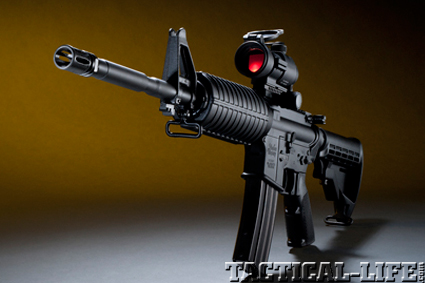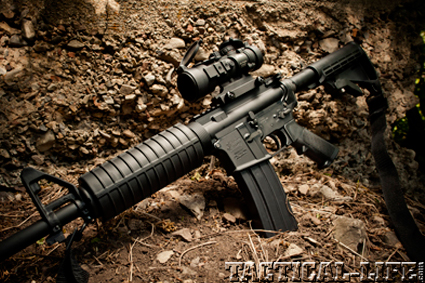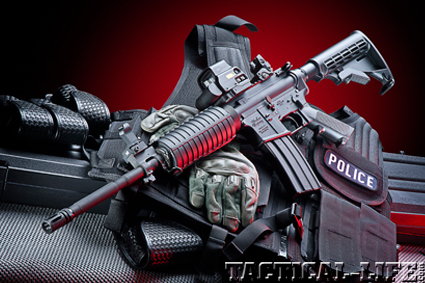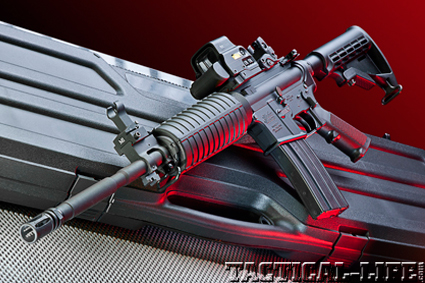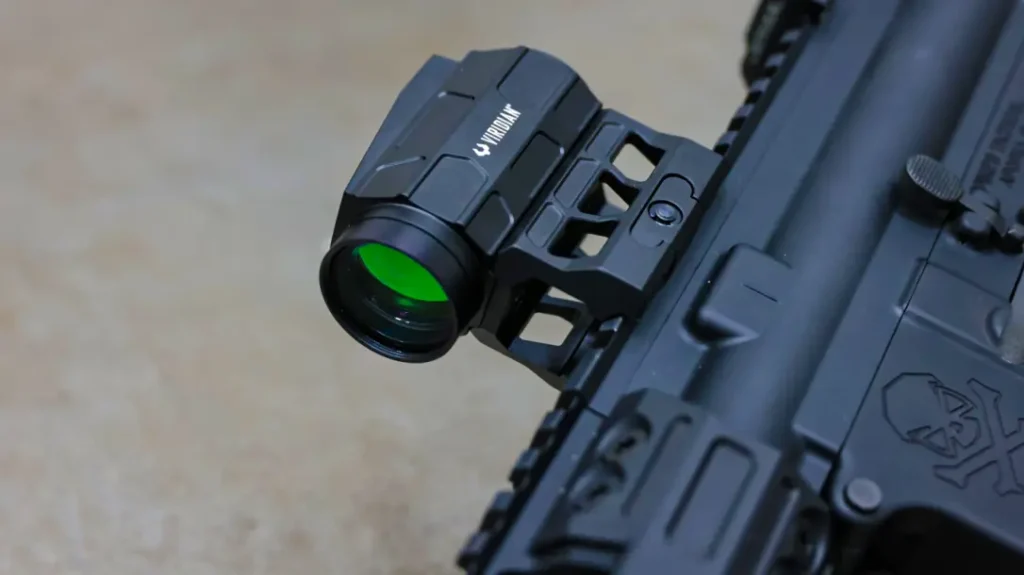Windham Weaponry, by now a well-known and well-established player in the AR market, has one goal: to build the finest AR-type rifles in the country. The company is so sure of the quality of its rifles that it backs them up with the strongest warranty in the industry, guaranteeing against all manufacturer’s defects in material and workmanship for the lifetime of the firearm. Windham plans on adding more models in the future. Until then, we have a roundup of their already excellent examples of the AR.
HBC—Heavy Barrel Carbine
Windham has a new heavy-barrel carbine, the HBC. It offers all the advantages of the company’s standard rifles and then some. Made in Windham, Maine, by a cadre of veteran AR-makers with decades of experience, these rifles have found increased acceptance among civilians and law enforcement, including Maine’s Department of Inland Fisheries and Wildlife police.
The HBC is a semi-automatic AR carbine with a direct gas impingement system chambered in 5.56mm NATO and featuring a heavy-contour, 16-inch barrel. Notably the barrel steel is Mil-B-11595E 4150 chrome-moly-vanadium, which makes the barrel truly mil-spec with the proper amount of carbon and vanadium to strengthen it. This high-quality steel is not needed for most sport uses, but it is in a rifle designed for serious duty or full-auto fire. The barrel is also chrome-lined for added durability and reliability.
Advertisement — Continue Reading Below
The advantages of having a heavy barrel is that the extra weight toward the front of the rifle not only dampens recoil but also helps prevent muzzle rise, keeping the rifle on target more easily for faster follow-up shots. The thicker and stiffer barrel profile also helps minimize point-of-impact shift as a result of using a sling or bipod, which can improve accuracy. A thicker barrel also takes longer to heat up, which can improve user comfort. The Windham Weaponry HBC only adds about half a pound in weight to Windham’s comparable M4-profile AR carbine.
The barrel has a fairly standard 1-in-9-inch twist rate, which does a good job of stabilizing a wide range of bullet weights, including very low weight, special-purpose bullets. Another mil-spec feature is the addition of M4 feed ramps at the back of the chamber. These are cut wider and lower than those for the AR rifle and are designed to improve reliable feeding of rounds from the magazine into the chamber. This can be especially important in carbines and under less-than-ideal conditions where dirt, grime and moisture can be introduced.
The standard threaded muzzle is topped off with a removable A2 flash suppressor, and the front sight base is elevation adjustable. Some folks are sticklers for properly F-marked bases on carbines. The Windham Weaponry AR is not so marked, but this is a distinction with very little real-world application. Because of the difference in sight radius with a carbine over a rifle, an F-marked sight base is infinitesimally lower than a standard base. This is only an issue when using iron sights at distances past 200 yards, and it can be easily corrected by installing a taller front sight post.
Advertisement — Continue Reading Below
Both the upper and lower receivers are manufactured from forged 7075-T6 aluminum and feature a well-applied hardcoat black anodized finish. The upper receiver features a flattop design with a removable carry handle and A4 dual-aperture sights that are elevation and windage adjustable. There are no indexing marks on the top Picatinny rail, so users would need to take care when removing and replacing optics in order to maintain proper zero. The CAR black plastic handguards feature aluminum heatshields, which were extremely effective at protecting the carbine-length gas tube as well as my hand from a hot barrel during a full day of range testing.
The bolt and bolt carrier are also both phosphated and chrome-lined. The bolt carrier has a mil-spec M16 contour, as opposed to a cheaper commercial bolt, which is stronger and heavier to ensure longer and more reliable operation, and it’s paired off with a standard carbine buffer. It should be noted that mil-spec M16 bolt carriers are legal to install in semi-auto rifles.
The controls on both the upper and lower receivers (dustcover, forward assist, bolt release, magazine release, charging handle and safety selector) are all located in the familiar places with nothing ambidextrous. There are clear safety-selector indicator markings on both sides of the receiver, so the rifle’s condition can be visually verified from either side. The triggerguard is the fold-down, aluminum type for use with gloves. The M4-type collapsible buttstock has six positions for length of pull, to adjust for the statures of different officers or for use while wearing body armor. The stock was well installed and exhibited excellent fit with very little play. The fit between the upper and lower receivers was very tight, and there was virtually no play between them. Also, the lower receiver features a standard military-type plastic pistol grip with finger grooves and a slightly flared magazine well. The Windham Weaponry logo is prominently displayed on the left side of the magazine well and consists simply of the company name in a cursive-type script.
Advertisement — Continue Reading Below
Shots Downrange
On the range the added weight did indeed soak up some of the already low recoil of the .223 round and made shooting significantly more enjoyable. Also, it was definitely easier to keep the sights on target for faster follow-up shots. I tested the rifle right out of the box and experience no malfunctions of any sort over two days on the range, with no maintenance performed in between. For accuracy testing I used the Trijicon TR20-2 3-9x40mm AccuPoint scope and a mil-dot crosshair reticle with an amber dot to check for accuracy at 100 yards while firing from a stable benchrest. The excellent fiber optics on the Trijicon scope gather ambient light to illuminate the center amber dot without batteries. This is a very welcome feature, especially for anyone who has hit the range with a red-dot or illuminated scope only to find a dead battery.
From a benchrest at 100 yards, accuracy was actually quite good, especially for a patrol rifle. The average spread for all types of ammunition tested was under 2 MOA, and one five-shot group of 5.56mm Winchester 55-grain FMJ ammunition produced a sub-MOA group. This just once again proves how dependent each individual rifle is on the type of ammunition used—I have seen good-quality rifles go from sub-MOA to 4 MOA just based on ammunition selection.
Wrap Up
Windham Weaponry ships its rifles in a black, hard plastic case with one 30-round magazine, a sling and a well-illustrated operator’s manual. For civilian purchase, there are California and other state compliant models available, as well as a more optics-ready carbine with no front sight, a tactical model with all the bells and whistles, and a long-barreled varmint rifle. Interestingly, Windham Weaponry has also released an ultra-lightweight AR with a carbon-fiber upper and lower receiver.
Advertisement — Continue Reading Below
I have tested nearly all of Windham’s offerings and have never had a single malfunction or poor accuracy results. At Windham, there appears to be no cutting of corners or sacrificing on quality, and this is a level of dependability that is sure to be appreciated by any shooter. For more information, visit windhamweaponry.com or call 855-808-1888.
